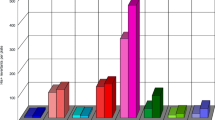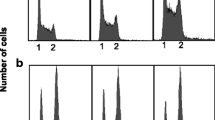Summary
The λdv plasmid genome is composed of two regions: (1) the autorepressor region which consists of promoter-operator (pRoR) and autorepressor (tof) and (2) the origin region which consists of the origin of replication (ori) and two initiator genes (O and P) (Matsubara 1976). Replication of this plasmid is directly connected with transcription from pRoR. Using λdvs having various mutations in pRoR, the transcription ability was examined in detail in connection with the control mechanism of replication.
The transcription ability of the autorepressor region is controlled by the binding affinity of the tof protein and pRoR. Thus, at steady-state, λdvs carrying a highly-constitutive (‘strong’) pRoR produced the autorepressor at high levels, whereas those carrying a low-constitutive (‘weak’) pRoR produced the autorepressor at low levels. This relationship did not change even when a fragment of λdv genome covering the autorepressor region was cloned into the plasmids pBR322 and pSC138, which could be maintained in a fixed amount within a cell. It was also shown that the autorepressor level at steady-state is a function of copy number of the DNA carrying the region for autorepression. These observations fit the autorepression model of Sompayrac and Maaløe (1973), which predicts that a decreased level of autorepressor activates pRoR and initiates transcription which leads to the production of tof protein until a new steady-state is established. By the same token, if the affinity of autorepressor and pRoR is decreased, pRoR remains active until a higher level of autorepressor is produced.
Transcription of the autorepressor region directly affects the level of transcription of the origin region which is located distal to the promoter. Thus, the ability to replicate is connected with an ability to produce autorepressor. The λdv plasmids with ‘strong’ or ‘weak’ pRoR were maintained at a high or low copy number, respectively.
The phenomenon of incompatibility of λdv was also examined using pBR322 and pSC138 plasmids carrying the cloned autorepressor region of λdv. The chimeric plasmids with ‘strong’ pRoR exhibited strong incompatibility with λdv, whereas those with ‘weak’ pRoR showed weak incompatibility. This indicates that interaction of the autorepressor and pRoR is related to the incompatibility of λdv plasmids.
Similar content being viewed by others
References
Allet B, Jeppesen PGN, Katagiri KJ, Delius H (1973) Mapping of the DNA fragments produced by cleavage of λ DNA with endonuclease RI. Nature 241:120–123
Bolivar F, Rodriguez RL, Greene PJ, Betlach MC, Heyneker HL, Boyer HW, Crosa JH, Falkow S (1977) Construction and characterization of new cloning vehicles II. A multipurpose cloning system. Gene 2:95–113
Clewell DB (1972) Nature of ColE1 plasmid replication in Escherichia coli in the presence of chloramphenicol. J Bacteriol 110:667–676
Denniston-Thompson K, Moor DD, Kruger KE, Furth ME, Blattner FR (1977) Physical structure of the replication origin of bacteriophage lambda. Science 198:1051–1056
Dove WF, Hargrove E, Ohashi M, Haugli F, Guha A (1969) Replicative activation in lambda. Jap J Genet 44 Suppl 1, 11–22
Echols H, Green L (1971) Establishment and maintenance of repression by bacteriophage lambda. The role of the cI, cII, and cIII proteins. Proc Natl Acad Sci USA 68:2190–2194
Echols H, Murialdo H (1978) Genetic map of bacteriophage lambda. Microbiol Rev 42:577–591
Flashman SM (1978) Mutational analysis of the operators of bacteriophage lambda. Mol Gen Genet 166:61–73
Folkmanis A, Takeda Y, Smith J, Gussin G, Echols H (1976) Purification and properties of a DNA-binding protein with characteristics expected for the Cro protein of phage lambda: A repressor essential for lytic growth. Proc Natl Acad Sci USA 73:2249–2253
Goebel W, Bonewald R (1975) Class of small multycopy plasmids originating from the mutant antibiotic resistance factor R1drd-19B2. J Bacteriol 123:658–665
Hashimoto T, Matsubara K (1974) Transformation of Ca++-treated recA derivative of Escherichia coli K12 by λdv DNA. Jap J Genet 49:97–101
Helling RB, Goodman HM, Boyer HW (1974) Analysis of endonuclease R.EcoRI fragments of DNA from lambdoid bacteriophages and other viruses by agarose-gel electrophoresis. J Virol 14:1235–1244
Hobom G, Grosschedl R, Lusky M, Scherer G, Schwarz E, Kössel H (1979) Functional analysis of the replicator sturcture of lambdoid bacteriophage DNAs. Cold Spring Harbor Symp Quant Biol 43:165–178
Hsiang MW, Cole RD, Takeda Y, Echols H (1977) Amino acid sequence of Cro regulatory protein of bacteriophage lambda. Nature 270:275–277
Johnson A, Meyer BJ, Ptashne M (1978) Mechanism of action of the cro protein of bacteriophage λ. Proc Natl Acad Sci USA 75:1783–1787
Koga H, Horiuchi T (1973) Studies on lambda virulent mutants. II. Antirepression and vir-repression function of virC and virC-virR. Mol Gen Genet 124:219–232
Kool AJ, Nijkamp HJJ (1974) Isolation and characterization of a copy mutant of the bacteriocinogenic plasmid Clo DF13. J Bacteriol 120:569–578
Lusky M, Hobom G (1979) Inceptor and origin of DNA replication in lambdoid coliphages. II. The λ DNA maxmal replication system. Gene 6:173–197
Manis JJ, Kline BC (1977) Restriction endonuclease mapping and mutagenesis of the F sex factor replication region. Mol Gen Genet 152:175–182
Manis JJ, Kline BC (1978) F plasmid incompatibility and copy number genes. Their map locations and interactions. Plasmid 1:492–507
Matsubara K (1974) Interference in bacteriophage growth by a resident plasmid λdv. II. Role of the promoter-operator. J Virol 13:603–607
Matsubara K (1976) Genetic structure and regulation of a replicon of plasmid λdv. J Mol Biol 102:427–439
Matsubara K, Takagi Y, Mukai T (1975) In vitro construction of different oligomeric forms of λdv DNA and studies on their transforming activities. J Virol 16:479–485
Matsubara K, Otsuji Y (1978) Preparation of plasmids from lambdoid phages and studies on their incompatibilities. Plasmid 1:284–296
Meijer M, Beck E, Hansen FG, Bergmens HN, Messer W, von Meyenbug K, Schaller H (1979) Nucleotide sequence of the origin of replication of the Escherichia coli K-12 chromosome. Proc Natl Acad Sci USA 76:580–584
Morris CF, Hashimoto H, Mickel S, Rownd R (1974) Round of replication mutant of a drug resistance factor. J Bacteriol 118:855–866
Murotsu T, Tanaka H, Imaji M, Koga H, Matsubara K, Horiuchi T (1977) Purification and properties of a λ operator-binding protein which is expected to be autorepressor (tof-protein) from E. coli carrying λdv plasmid. Mol Gen Genet 157:139–147
Nordström K, Ingram LC, Lundback A (1972) Mutations in R-factors of Escherichia coli causing an increased number of R-factor copies per chromosome. J Bacteriol 110:562–569
Oka A, Nomura N, Morita M, Sugisaki H, Sugimoto K, Takanami M (1979) Nucleotide sequence of small ColE1 derivatives: Structure of the regions essential for autonomous replication and colicin immunity. Mol Gen Genet 172:151–159
Old R, Murray K, Roizes G (1975) Recognition sequence of restriction endonuclease III from Haemophilus influenzae. J Mol Biol 92:331–339
Roberts JW (1970) The rho factor: Termination and anti-termination in λ. Cold Spring Harbor Symp Quant Biol 35:121–126
Roberts TM, Shimatake H, Brady C, Rosenberg M (1977) Sequence of cro gene of bacteriophage lambda. Nature 270:274–275
Robinson LH, Landy A (1977) HindII, HindIII, and HpaI restriction fragment maps of bacteriophage λ DNA. Gene 2:1–31
Rosenberg M, Court D, Shimatake H, Brady C, Wulff DL (1978) The relationship between function and DNA sequence in an intercistronic regulatory region in phage λ. Nature 272:414–423
Scherer G (1978) Nucleotide sequence of the 0 gene and the origin of replication in bacteriophage lambda DNA. Nucleic Acids Res. 5:3141–3156
Sharp PA, Sugden B, Sambrook J (1973) Detection of two restriction endonuclease activities in Haemophilus parainfluenzae using analytical agarose-ethidium bromide electrophoresis. Biochemistry 12:3055–3063
Sompaylac L, Maaløe O (1973) Autorepressor model for control of DNA replication. Nature New Biol 241:133–135
Streeck RE, Hobom G (1975) Mapping of cleavage sites for restriction endonuclease in λdv plasmid. Eur J Biochem 57:595–606
Sugimoto K, Oka A, Sugisaki H, Takanami M, Nishimura A, Yasuda Y, Hirota Y (1979) Nucleotide sequence of Escherichia coli K-12 replication origin. Proc Natl Acad Sci USA 76:575–579
Sutcliffe JG (1979) Complete nucleotide sequence of the Escherichia coli plasmid pBR322. Cold Spring Harbor Symp Quant Biol 43:77–90
Takeda Y, Folkmanis A, Echols H (1977) Cro regulatory protein specified by bacteriophage λ. J Biol Chem 152:6177–6183
Timmis K, Cabello F, Cohen SN (1975) Cloning, isolation, and characterization of replication regions of complex plasmid genomes. Proc Natl Acad Sci USA 72:2242–2246
Tomizawa J (1971) Functional cooperations of genes O and P. In: Hershey AD (ed). The Bacteriophage lambda Cold Spring Harbor Laboratory, New York, p 549
Yoshimori RN (1971) Ph.D. Thesis, University of California, San Francisco
Author information
Authors and Affiliations
Additional information
Communicated by T. Yura
Rights and permissions
About this article
Cite this article
Murotsu, T., Matsubara, K. Role of an autorepression system in the control of λdv plasmid copy number and incompatibility. Molec. Gen. Genet. 179, 509–519 (1980). https://doi.org/10.1007/BF00271740
Received:
Issue Date:
DOI: https://doi.org/10.1007/BF00271740




